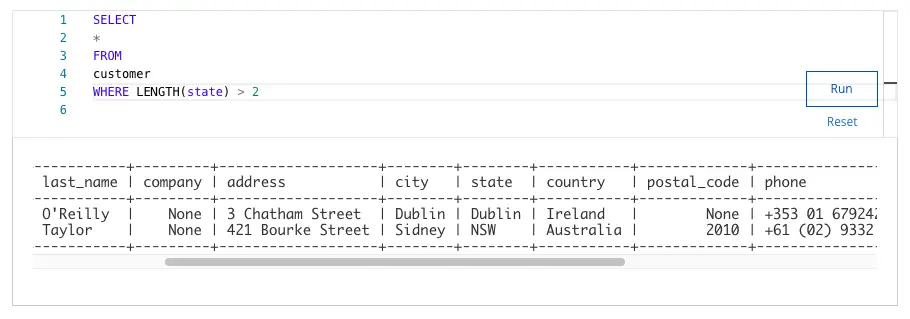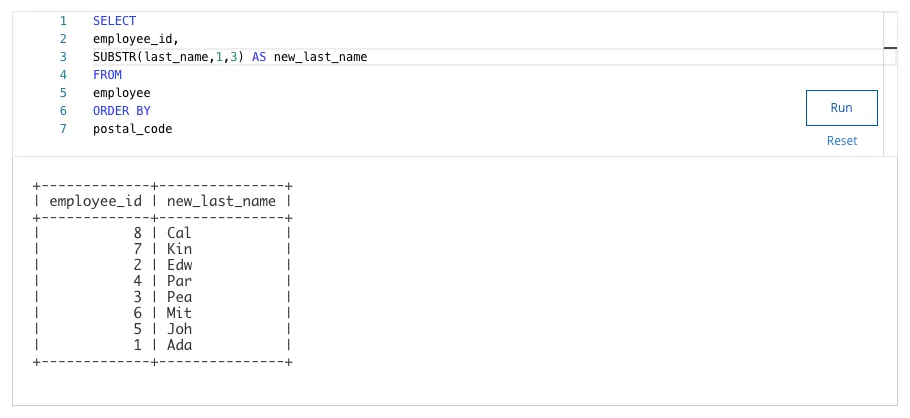34. In SQL databases, what function can be used to convert data from one datatype to another?
- CAST
- LENGTH
- TRIM
- SUBSTR
35. After a company merger, a data analyst receives a dataset with billions of rows of data. They need to leverage this data to identify insights for upper management. What tool would be most efficient for the analyst to use?
- Spreadsheet
- Word processor
- SQL
- CSV
36. You are working with a database table that contains customer data. The table includes columns about customer location such as city, state, country, and postal_code. The state names are abbreviated. You want to check for state names that are greater than 2 characters long.
You write the SQL query below. Add a LENGTH function that will return any state names that are greater than 2 characters long.

What country is in row 1 of your query result?
NOTE: The query index starts at 1 not 0.
- Ireland
- India
- France
- Chile
37. You are working with a database table that contains employee data. The table includes columns about employee location such as city, state, country, and postal_code. You use the SUBSTR function to retrieve the first 3 characters of each last_name, and use the AS command to store the result in a new column called new_last_name.
You write the SQL query below. Add a statement to your SQL query that will retrieve the first 3 characters of each last_name and store the result in a new column as new_last_name.
NOTE: The three dots (...) indicate where to add the statement.
NOTE: SUBSTR takes in three arguments being column, starting_index, ending_index

What employee ID number is in row 8 of your query result?
NOTE: The query index starts at 1 not 0.
- 7
- 3
- 1
- 8
38. A data analyst runs a SQL query to extract some data from a database for further analysis. How can the analyst save the data? Select all that apply.
- Download the data as a spreadsheet.
- Use the UPDATE query to save the data.
- Create a new table for the data.
- Run a SQL query to automatically save the data.
39. A data analyst notices their Boolean column is incorrectly storing True/False values as strings. What function can the analyst use to convert the data type from a string to Boolean?
- CAST
- TRIM
- LENGTH
- SUBSTR
40. A data analyst is cleaning survey data. The results for an optional question contain many nulls. What function can the analyst use to eliminate the null values from the results?
- COALESCE
- CONCAT
- CAST
- LENGTH
41. A data analyst is analyzing medical data for a health insurance company. The dataset contains billions of rows of data. Which of the following tools will handle the data most efficiently?
- A word processor
- CSV
- A spreadsheet
- SQL
42. You are working with a database table that contains invoice data. The table includes columns for invoice_id and billing_city. You want to remove duplicate entries for billing_city and sort the results by invoice_id.
You write the SQL query below. Add a DISTINCT clause that will remove duplicate entries from the billing_city column.
NOTE: The three dots (...) indicate where to add the clause.

What billing city appears in row 15 of your query result?
NOTE: The query index starts at 1 not 0.
- London
- Reno
- Santiago
- Oslo
Shuffle Q/A 4
43. You are working with a database table that contains invoice data. The table includes columns about billing location such as billing_city, billing_state, and billing_postal_code. You use the SUBSTR function to retrieve the first 4 numbers of each billing_postal_code, and use the AS command to store the result in a new column called new_postal_code.
You write the SQL query below. Add a statement to your SQL query that will retrieve the first 4 numbers of each billing postal code and store the result in a new column as new_postal_code.
NOTE: The three dots (...) indicate where to add the statement.
NOTE: SUBSTR takes in three arguments being column, starting_index, ending_index

What invoice id is located in row 4?
NOTE: The query index starts at 1 not 0.
- 32
- 104
- 52
- 206
44. In which of the following situations would a data analyst use SQL instead of a spreadsheet? Select all that apply.
- When quickly pulling information from many different sources in a database
- When recording queries and changes throughout a project
- When working with a huge amount of data
- When using the COUNTIF function to find a specific piece of information

